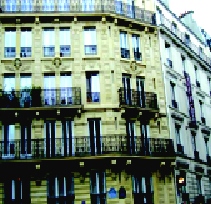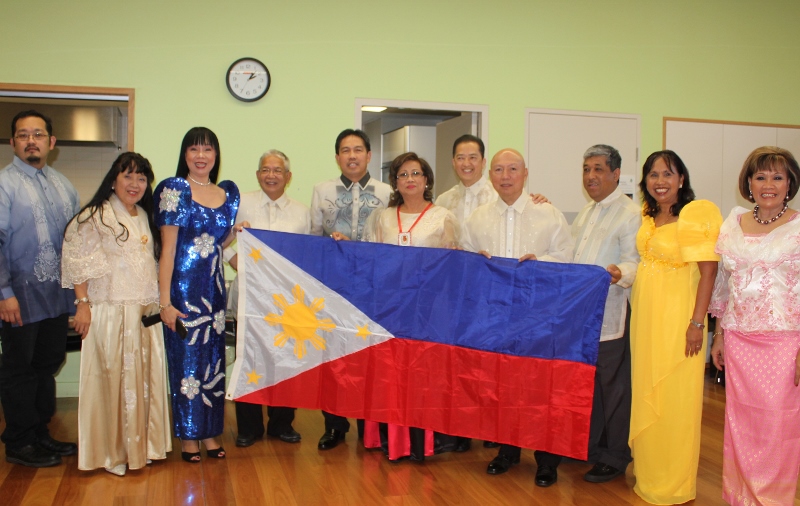 LIKE in Paris, I arrived in Madrid around 9am, with the shuttle bus driver waiting at the airport arrival area, He took me to Hotel Asturias where I would stay for the next six nights in the Spanish capital.
LIKE in Paris, I arrived in Madrid around 9am, with the shuttle bus driver waiting at the airport arrival area, He took me to Hotel Asturias where I would stay for the next six nights in the Spanish capital.
In the afternoon, after a short rest, I explored the closest streets to my hotel and tried to find out if I could also use the underground train in my visit. I found the railroad system in Madrid a little bit confusing for me, so I decided to just walk to places I wanted to visit. I had my first Spanish tapa and paella in the evening. It cost me 12 Euro for a meal. Initial areas visited were Plaza Mayor and Puerta del Sol.
Rizal spent the greatest part of his time Europe in Spain, from 1882 to 1885. He stayed longest in Madrid where he completed his courses in medicine, philosophy art, and gymnastic at the Central University. The university is now relocated outside Madrid. Rizal attended lessons in painting and sculptures at the San Fernando Fine Arts Academy, also in Madrid.
Writing in his diary, for January 4, Rizal wrote: ‘This morning I went to the Faculty of San Carlos. They told me that we do not have a class until the 7th: in Greek there was a class from yesterday. From there I went to the Academy of San Fernando and there they gave me new lessons. This morning we met at the Cafe de Madrid through an invitation sent me by Graciano [Lopez-Jaena].’
The building of the academy is still standing and during my visit has an exhibition called ‘Buscame’ featuring magni-ficent works held in the Royal Academy of Fine Arts of San Fernando. Among its noted art pieces today are works of Giuseppe Arcimboldo, Ribera, Zurbaran, Collantes, Rubens, Carreno de Miranda, Peredak, Goya, Zuloaga, Sorolla and Picasso.
Tracing the footsteps of Rizal in Spain was originally assigned to Dr. Bantug, but he felt ill in Madrid and forced him to return to Manila. It was Dr. Alip, then in Paris doing similar task, who was asked to replace him to continue the historical re-tracing of the national hero’s time in the Spanish capital. Dr. Alip spent more than three weeks completing Dr. Bantug’s original assignment in Spain, mostly in Madrid and Barcelona.
Describing his early student days in Madrid, Rizal said: ‘Among our countrymen, I am taken as studious and sufficiently able, but when I compare myself with many young men whom I have known in foreign lands, I confess frankly that I find myself on a much lower level and a conclude that to reach their standards, I would need many years of study, much luck, and much more applications; yet those young men are younger than I am.’
It was in Madrid in 1884 that the Filipino colony celebrated the winning of Juan Luna and Felix Resurrecion Hidalgo for the former Spoliarium which was awarded the first prize in cash and Hidalgo’s entry receiving honourable mention in the Exposicion Nacional de Bellas Artes in Madrid in 1884. The art competition was participated in by Spaniards, Frenchmen, Italians and other nationalities.
The first day of my stay in the Spanish capital, I joined a Madrid small-group walking tour, including a visit to the Royal Palace, with an English speaking guide. At the Royal Palace, we were guided to the throne room, banqueting rooms and royal apartments and learned bits and pieces of information you don’t normally read in textbooks. The Baroque grandeur of the Royal Palace or known as Palacio Real was given more meaningful to me when we were able to tour the royal collections. It was the highlight of the day’s tour activities.
The following day, it was time to savour the museum scene in Madrid, this time I joined the skip the line Pardo Museum express ticket tour of Spain’s national art museum featuring mesmerizing gallery containing around 9,000 paintings, not to mention the number of sculptures, prints and drawings in the museum catalogue. Luckily, there were only two of us that turned up for the scheduled guided tour so we had a good time discussing with the tour guide about the Prado Museum collections. It was a blessed morning of one and half tour devoted mostly on influential pieces of European artwork and we were informed of the history of iconic Neo-Classical building while walking around admiring masterpieces like Velazquez’s popular Las Meninas.
We learned that the main building of the Prado Museum was commissioned by King Charles III to be built during the late 18th century. Not soon after, the original building was crowded by the sheer amount of art objects that have been collected by the early museum curators and administrators. So, two further annexes were added to hold the rapidly growing huge collection.
An additional information provided by the guide was about the different artistic movements that the museum represents. Although the guide’s intention was only to concentrate on three major Spanish painters like Goya, Velazquez and Titian, our spontaneous questioning forced her to mention other painters like Peter Paul Rubens and Dutch painter Hieronymus Boch.
The guide also explained the influential pieces of artwork by Italian supremos like Fra Angelico’s The Annunciation and Tinteretto’s Christ Washing the Disciple’s Feet, and explained the differences between the different artistic periods, like Renaissance and Baroque. When the tour was completed, the guide provided us with information about the museum amenities and told us that we could stay until closing times and explore the other parts of the collection as independent guests.
The third day was an out of town half day tour visiting the fortified city of Avila in the mountainous areas overlooking a vast plain of undulating land. The landscape reminded me of my long travel between Laoag City and Badoc, the last town in Ilocos Norte with the Ilocos Sur boundary. The landscape is brown as if it was neglected by the rainmakers above.
The city was the hometown or birthplace of St. Theresa de Avila. Part of this tour was a side trip to Segovia, near Valladolid, where we viewed the famous aqueduct and the cathedral. The aqueduct built without mortar using brick-like granite blocks. It was partly restored in the 15th century after major portion of its original structure was destroyed by the Moors in 1072. Segovia is one of nine provinces that make up the autonomous region of Castile and León.
In Avila, which is located to the west of Segovia, we visited the Basilica of San Vincente and in Segovia, we entered the less known Alcazar Palace, with its Artillery Museum and Church of Vera Cruz. The Alcazar Palace of Segovia, also known as Segovia Castle, is a stone fortification located in the old city of Segovia. It is one of the most distinctive castle-palaces in Spain and became inspirations for Walt Disney’s Cinderella Castle, in countless Disney movies.
My most memorable stay in Madrid was a visit to El Escorial Monastery and the Valley of the Fallen and a Panoramic Madrid Sightseeing Tour which covered the whole day activity. The Royal Seat of San Lorenzo de El Escorial is the historical residence of the Kings of Spain and located in the town of San Lorenzo de El Escorial, about 45 kilometres (28miles) northwest of Madrid. It is one of the Spanish royal sites and functions as a monastery, royal palace, museum, school, and the catacomb or the pantheon of kings located down below ground level and can be viewed only by descending on a narrow stone steps to the lowest part of structure.
We visited the two architectural complex comprising this historical sites which was listed by UNESCO in the World Heritage Site in 1984. According to Wikipedia, early in its history it was the royal monastery, a royal hunting lodge, and monastic retreat. It was during the 16th and 17th centuries, that El Escorial became the places in which the power of the Spanish monarchy and the ecclesiastical predominance of the Roman Catholic religion in Spain found a ‘common architectural manifestation.’ Originally, it was a property of the Hieronymite monks, but now a monastery of the Order of St. Augustine. King Philip II whose long reign was 1556-1598 built the complex at El Escorial with Spanish architect, Juan Bautista de Toledo who was assigned to draw the plan. He would be the main collaborator of the king in the design of El Escorial. Juan Bautista spent the greater part of his career in Rome where he was also claimed to have worked on the basilica of St. Peter’s and in Naples, Italy, where he served the king’s viceroy. King Philip II and Bautista designed the El Escorial as a monument to Spain’s role as a center of the Christian world. Its popularity for visitors is seen through the massive number of visitors coming to the El Escorial every year which is placed at more than 500,000 annually.
The monument called Valley of the Fallen is located at Cuelgamuros Valley, near Madrid. It was conceived by the late Spanish dictator Francisco Franco to honour and bury those who fell during the Spanish Civil War. During his later life, Franco regarded the building of the monument as a ‘national act of atonement’ and reconciliation. It is a surviving artefact of Franco’s rule, and the monument and its Catholic remain controversial, particularly because 10% of the construction workforce were convicts, some of them were political prisoners.
A 20th century Spanish architecture, it was designed by Pedro Muguruza and Diego Mendez on scale to equal, according to Franco, ‘the grandeur of the monuments of old, which defy time and forgetfullness’.
The monument cover over 3,360 acres of Mediterranean woodlands and granite boulders on the Sierra de Guadrrama hills, and located on top measuring 3,000 feet (910m) over sea level where the Basilica, the Benedictine Abbey, the Hispederia, the Valley and the Juanelos, four cylindrical monolith dating from the 16th century are found. It was started in 1940 and completed 18 years later and finally inaugurated in 1959. There is a 150-meter high (500 ft) cross erected over a granite outcrop 150 meters over the basilica esplanade and visible from over 20 miles away.








Leave a Reply